Throughout its history, the Troop has had various meeting places. Mr. L. Baker and Mr. M. Jerrom started the Scout Troop in 1933. In those days the School (Hastings Grammar School as it was then) was in Nelson Road, not far from the Town Centre. The Scouts held their meetings in the School, usually in the gymnasium. They met twice a week, on Mondays and Fridays. From a beginning of 6 Scouts, the Troop quickly grew and flourished.
In 1939 the war started and on July 21st 1940 the whole School was evacuated to St. Albans where the Troop teamed up with other Hastings Scouts who had been evacuated. They met at the District Headquarters in Victoria Street and formed additional Patrols to cater for all the extra members. At one time there were 8 Patrols, and at Summer Camp during and after the war there were often over 60 people in camp. They used to put on a pantomime at Christmas each year (long before the District started the Scout Show). The Seniors started in 1937, 10 years before Headquarters officially began the Section, and there was usually a large Rover Crew. Rovers were Scouts over 18, who had their own activities, and helped to run the other Sections.

When I joined in 1964 Hastings Grammar School had only just moved to Parkstone Road. The Scout Group really was a part of the School in those days, just like cricket and football and music and drama. All the Scouters were teachers at the School, and only boys at the School were allowed to join. The School Captain and the prefects were quite likely to be Rovers.
All the Scouts wore their uniforms to School on a Friday – a green beret,khaki shirt and shorts, and long socks with green garter tabs. We had only a very small hut where the HQ now stands, and it had no heating; it had previously been used as the changing room for the running track, and the School Governors had it moved up to the copse for us.
Most of the time we held our meetings in the tower block in rooms F, G, H & J on the first floor and fall-in was on the landing. We had games in the Dutch Barn: what is now the ABJ cricket school, but then it was only enclosed on three sides. The side facing the roadway was only bricked in much later. We soon decided that these conditions were not for us, and we started to raise money to buy a better hut. In 1976 we were able to buy a large hut, second hand, from a property developer called Larkin in Bexhill. It had previously been used as a gymnasium by a private school and then by a workingmen’s club. When we went to see it at Collington, it had a corrugated iron roof and two wood-burning stoves, with stovepipes going out through the roof, and a stage at one end. We bought it for £400, but we then had to have it demolished, transported to Hastings and re-erected on our site. This cost about £10,000.
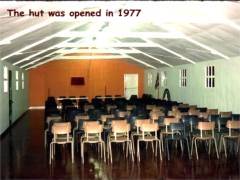
There was still no electricity supply suitable for heating it, but in those days we had a Group Supporters’ Association. They held fund-raising events like folk dances, tramp suppers, pyjama parties, beetle drives and so on, and they came up with the £1200 or so it cost to install a new cable underground from the art room. This cable still carries our electricity supply now, and is also used by the School to supply the cricket pavilion and the other little outhouses. Later, a water supply pipe was added, also paid for by the Supporters. Before that, all water had to be carried up to the hut from the School in containers. There was never any sanitation, but fortunately the copse is close by.
The Venture Scouts, mainly Roland Illman and John McDonagh soon got busy building themselves a den inside the new hut. They obtained the necessary timbers and knowledge, and had soon constructed a large room, which they then furnished with a carpet, chairs and stools, with built-in cupboards down the side. The room was papered and painted. Lighting circuits and a fridge quickly followed. Later Glen Russell painted Scout motifs on one wall, and the rest of Unit added other decorations. After the den, the next step was to install a small kitchen, so that refreshments could be adequately prepared, and also to enable cook badge courses to take place at the HQ.
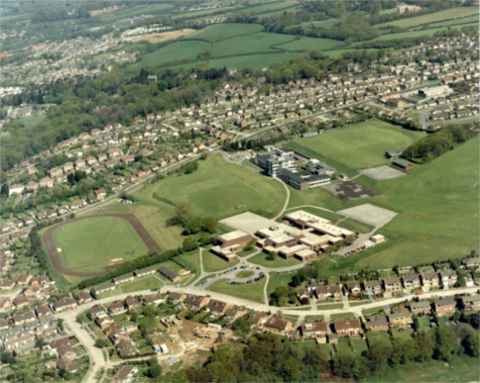
So we thrived and built up the Scout Troop and the Venture Unit. We started Cubs, and for a time we had a second Troop, called the Gilridge Troop, which was named after the camping field the District used to own above the School fields. But the terrible storm of 1987 with winds gusting to over 100 mph severely damaged the hut. Of course, we repaired it as best we could, but it was never the same again. It leaked, the weatherboard started to fall off the outside (with the help of vandals), the ceiling panels fell down and the windows rotted and had to be replaced.
In the end the Group Council decided that we were pouring good money after bad trying to patch it up, and in 1992 we resolved to go for a new brick-built HQ. This was before the National Lottery was invented, but we started running boot sales, auctions, etc. and diverted most of the money from our paper salvage collections to our new building fund.
We had countless consultations with Leaders and everyone who was interested, to decide what features to include in the new building. And we started asking for money.
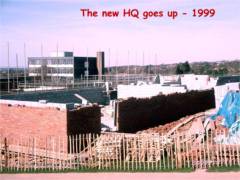
At first it came in only very slowly, and we were getting nowhere near our target. But then we had a breakthrough. The Isabel Blackman Foundation responded to our pleas for help with a magnificent donation of £25,000. Now we could start to plan in earnest. We engaged an architect to draw up plans, and we held committee meetings to try to steer the project to completion. In the meantime the Lottery Fund had come into being. The first time we applied to them, they turned us down, but at the second try we were granted £100,000. The way was now clear, and we invited tenders from various builders. After much discussion, one was appointed and eventually, in early 1999, the work began. Of course, there were still many hurdles to clear, but that is another story in itself.
Towards the end of 1999 we moved into the new building. We hadn’t long been in, when it was discovered that an error had been made in the planning, which meant that extra iron girders would have to be deployed to strengthen the structure. This took several months to arrange and accomplish, and meanwhile we were not allowed into the main hall, so once again we were homeless. This time we had to resort to hiring rooms in the School for our meetings, which obviously put quite serious constraints on what we could do. However, eventually this problem was sorted out, and we were once again able to move back into our HQ.
A further difficulty beset us in 2004, when we were informed by the School authorities that we would no longer be allowed the use of the Copse, which had been our training ground at least since 1964, and possibly longer. Fortunately, this ruling was partly reversed five years later, and on our return to the lower section of the Copse, we found a wilderness, which needed much work to return it to its former state and make it a safe and pleasant place for the youngsters.
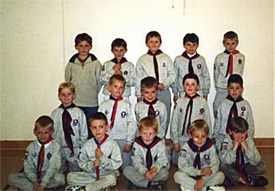
We had started Beavers, run by Ann Pope, as soon as the building was complete. Ann had several helpers from the Venture Unit and Troop, as well as adult volunteers. When Ann retired as Beaver Leader in 2016, Acorn Clayton, who had recently returned to us, took over the Colony. Martin, Paul and Kim were recruited to help.
Meanwhile, our Cub Pack, which had started life in January 1993 under Christine Parry, was led first by Judith Collins and her team, then by her daughter Claire, and later by Acorn Clayton; it had periods of great success and large numbers, interspersed with times when, owing largely to a shortage of Leaders, the numbers were smaller.
When Acorn left, Angela Johnson ran the Pack for a year or so, and then Lizzie Cockerton took over. Assistants now include Matthew Pelling and Callum Daniel, and the Pack has exxpanded and become involved in many interesting and varied activities.
During the years in the new hall, a lot of work still remained to be carried out. The most urgent was to deal with the reverberation in the main hall, which was so bad that it was quite impossible to understand what anyone was saying from a distance of more than a few yards. We commissioned some large baffle boards, filled with mineral wool, which cost a lot of money, but also went a long way towards curing this problem.
In 2002 we were once again without a Scout Leader, and so I took over the running of the Troop myself. This was at the time when the age range was reduced, and youngsters aged 15 were required to transfer to Explorers, the replacement Section for Ventures. The big difference was that Explorers were to be run by District and could not form part of the Group.
Meanwhile, the building was used every night of the week, by Rangers, Guides, Explorers, Beavers, Cubs and Scouts, and often at weekends for various activities.
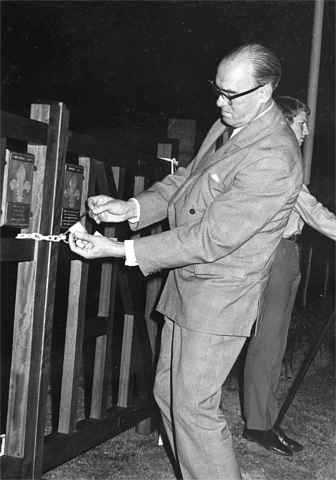
by Dr. Thomson
1968
In particular, the memorial gates, which we had removed for renovation, could not be replaced at the time, and so were languishing in the stores. We commissioned new gate posts and hinges, with a view to restoring the gates to their rightful position. New plaques were also needed to replace the old ones, which had been lost, and at our Open Night in May 2012 Peter Michell, the College Chaplain, came and rededicated the gates.
Meanwhile, the Troop camps continued. Whereas in earlier times the main emphasis had been on camping for the sake of it, now, while camping standards remained high, a much wider variety of activities became available. Among many highlights, the 2013 camp on Guernsey was in many ways typical of the modern approach. We camped with two Patrols of Scouts and two Patrols of Explorers; the mere fact of flying to camp was a first, and the activities included coasteering, sailing and kayaking on the sea, cycling to St Peter Port, building a lookout tower, and much else besides.
We’ve always taken a pride in the fact that the Scouts themselves cook all the main meals on wood fires, and that the menus include lots of interesting dishes from home and abroad.

